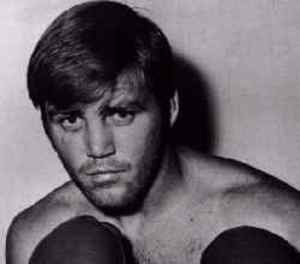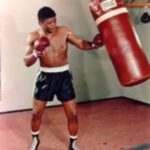Jerry Quarry was the perennial contender of late 1960s and early 1970s, Quarry was a fan favorite and participated in some of the most exciting fights of the heavyweight golden era. If he had fought in the heyday of Sonny Liston, Floyd Patterson or Ingomar Johansson, he would have won that world title. Give Quarry an extra inch of height and 10 pounds, and he would have surpassed fellow Irish heavyweight Gerry Cooney and given Larry Holmes the great arch-rival that would have defined him. At any time in the modern era of fragmented titles, Quarry would have easily captured a belt and defended it with pride and tenacity. It was just his bad luck to have fought at a time that included Muhammad Ali and Joe Frazier. “Irish” Jerry Quarry, “the Bellflower Bomber” is often called the best heavyweight to never win a title, and was the greatest of all the great white hopes.
The Comer Hits a Speedbump
The Quarry family was a fighting family. Quarry’s father and two of his brothers were also professional fighters. Quarry first put on the gloves at the age of five. He attracted attention at the 1965 National Golden Gloves, when he knocked out all five of his opponents on the way to claiming the national amateur heavyweight championship. Quarry remains the only heavyweight to accomplish such a feat.
Quarry turned pro in May 1965, and great things were expected of him. One ex-champion, Rocky Marciano, expressed interest in buying Jerry’s contract. While those negotiations were in progress, Quarry met Eddie Machen in July 1966. Machen was a former #1 contender who had seen better days (he had lost four out of his last six), which was why Quarry’s people wanted him: Machen had a name, and would be a test, but not a risky one. They underestimated Machen, who handed his Quarry his first loss. Any business interest on Marciano’s part evaporated. Quarry, undaunted, went back to the gym and set to work.
Quarry was an all-around solid fighter, but with limitations. He was durable, had a tough chin, and plenty of heart. He was a skilled counter-puncher, arguably the best of the era. Quarry packed pop in both hands, but had an especially mean left hook. He also had a fearsome body attack. Quarry was held back by two problems. One, at 6′ tall and weighing in between 195-200lbs during his prime, Quarry was a small heavyweight by the standards of the time. Second, he tended to cut easily, leading to stoppages at the hands of fighters who had no hope of denting his formidable chin. Still, even though he was smaller than his rivals and had soft skin, Quarry had the tools to achieve greatness.
Title Shots
Quarry fought eight times after the loss to Machen, all wins excepting his first meeting with two-time former world champion Floyd Patterson. Many think of Patterson as being washed-up by the late ’60s, but he was only 32 years old and still a serious contender. Although past his best, in the previous three years he had beaten Eddie Machen, Henry Cooper, and tough George Chuvalo, balanced against a loss to the young Muhammad Ali. He was still a crafty and dangerous boxer, and Quarry held him to a draw in their first, June 1967 encounter.
Quarry was now considered a top ten contender. Muhammad Ali had been stripped of his title for evading the draft, and the WBA arranged for a box-off to establish a new champion. Quarry was invited to participate. He met Patterson again in October 1967 in the first round of the tournament, and improved on his previous performance. Quarry knocked Patterson down in the 2nd, which was enough to eek out a majority decision (one judge had it a draw, with the other two scoring Quarry ahead by only one point – the knockdown literally won him the fight). He then went on to knockout Thad Spencer in the next stage of the tournament, and met Muhammad Ali’s former sparring partner Jimmy Ellis in the final. Ellis was a slickster and former middleweight, and like Quarry usually suffered from being the little guy in the ring. Yet despite being the faster, better skilled boxer, and finally fighting a man who was the same size, Ellis was barely able to pull out the win with a majority decision. Quarry had given the new WBA title holder all he could handle.
Quarry went back to work, racking up five wins, including roughing up the always-overweight fringe contender Buster Mathis. His performance against Ellis and defeat of Mathis earned him a title shot at Joe Frazier, who was then the “New York World Champion.” The two left hookers met in June 1969, matching Quarry’s counter-punching against Frazier’s smoking, relentless advance. The slugfest remains a classic, and became Ring magazine’s Fight of the Year. For two rounds, Quarry out-slugged the era’s consummate slugger. Yet in doing so, he was fighting Frazier’s fight, and ultimately his skin betrayed him. Frazier stopped Quarry with a bad cut over his eye after the 7th.
Quarry began rebuilding his career, and met fellow white hope George Chuvalo later that year. In Chuvalo, Quarry was facing the toughest man Canada has ever produced. George Chuvalo fought Muhammad Ali, George Foreman, Joe Frazier, and other top heavyweights in a career that spanned the 1960s: no one ever knocked him down. Quarry outboxed and busted up the plodding Cannuck for six rounds, but couldn’t really faze him. Chuvalo caught Quarry and knocked him down in the 7th. Quarry rose at the count of 10, but that margin was too close and he was counted out. The loss remains controversial, as Quarry was on his way to out-boxing Chuvalo and could clearly continue.
With losses to Ellis, Frazier, and Chuvalo, Quarry was starting to look overrated at the age of 25. Thus, he looked to be a ripe stepping stone for 24-0, up-and-coming Mac Foster. Quarry re-established himself with a brutal knockout of Foster in the 6th. Foster was never the same fighter after the loss, and his career went into a tailspin.
In with The Greatest
Jerry Quarry stood as a serious contender, and was selected to be Muhammad Ali’s first opponent upon his October 1970 return from exile. Quarry gave the rusty Ali a very hard time in the first two rounds, but Ali’s slicing fast hands opened a deep cut (it was reported that bone was visible) on Quarry in the 3rd. Once again, Quarry was betrayed by his soft skin: how would sports history be different if Quarry had sent Ali crashing down in defeat in his first comeback fight?
The loss on a freakishly bad cut (it was bad even by Quarry’s lacerated standards) so early in the fight led to enthusiasm for a rematch, which came in 1972. Although the first fight had obvious racial overtones (Quarry had been selected for that very reason), the rematch was even uglier: an early Don King production, the fight was billed “The Soul Brothers vs. The Quarry Brothers” (Jerry’s light heavyweight brother Mike challenged world champion Bob Foster on the undercard). Ali was now tuned-up, while Quarry looked lethargic. Ali dominated the fight, handing Quarry his second stoppage that was not due to cuts. Many once again considered Quarry washed up.
Apogee
In 1973, Quarry had the best year of his career. Far from being washed-up, he met two of the most feared punchers of the era, beat them both, and was ducked by a third.
In February 1973, Quarry met the undefeated, much larger Ron Lyle. He thoroughly outboxed Lyle, using his speed and mobility to move in and out, setting the pace of the fight and never giving the hard-punching Lyle a chance to plant his feet and unload. While not one of the most renowned punchers of the era, Quarry could hit and that kept Lyle honest. Also, Quarry did not get one of his infamous cuts that night. Many consider his performance against Lyle to be Quarry’s career best. He won a decisive unanimous decision. He followed that victory with a crushing first round knockout of powerhouse Earnie Shavers.
Despite having beaten two top contenders that year, then champion George Foreman refused to give Quarry a title shot. Later in life, Foreman admitted to being a fan of Quarry, and to dodging him throughout his career.
Instead, in 1974 Quarry met Joe Frazier again, in a much-anticipated rematch. Like so many of Quarry’s big fights, the bout was scheduled for June. The fight was very similar to the first: plenty of fireworks, close in the early rounds, but Frazier’s aggressive, swarming style kept Quarry from employing his trademark counters and forced him to slug. Frazier landed crushing hooks and knocked Quarry out in the 5th.
Following the loss to Frazier, Quarry was dodged by many contenders (certainly Lyle and Shavers wanted no part of him), but he eventually secured a big fight with Ali-conqueror Ken Norton in 1975. It was Quarry’s last hurrah. Fighting for the NABF title (a North American belt), Quarry was again stopped on cuts in the 5th.
Quarry had seen a lot of wars, been ranked as the #1 contender, challenged for versions of the world title twice, and made a fortune. He retired for the first time, with a record of 50-8-4 and 32 KOs. He did boxing commentary for ABC’s Wide World of Sports from 1975 to 1977, and turned his popularity to acting. All in all, Quarry should have been in for a happy retirement from boxing and a promising second career. However, in a familiar boxing story he could not resist the lure of the ring and the promise of big money fights, developed severe financial troubles, and returned to boxing and tragedy.
Struggling On
In 1977, Quarry made his first attempt at a comeback, beating Lorenzo Zanon by 7th round TKO. Perhaps sensing that the fight was much harder and more intense than it would have been five years ago, Quarry retired again.
This time, he stayed retired for five years. However, the financial pressures of failed business ventures and ex-wives forced him back to boxing. By now, Quarry was showing signs of pugilistic dementia, or “punch drunkenness.” He won twice in 1983, but his shocking mental decline caused him to be denied a license in most states. Desperate for money, he fought for the last time in 1992, receiving a pittance in exchange for a brutal mauling.
Within a few years of this last bout, Quarry was unable to feed or dress himself, and had to be cared for by the Quarry clan. Of the four Quarry brothers, three boxed professionally and all three came to suffer from pugilistic dementia. Jerry Quarry was inducted into boxing’s Hall of Fame in 1995, and passed away in 1999.
Acknowledgements
Thanks to the Jerry Quarry Foundation and Cyberboxngzone


